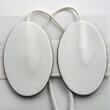Background
- Transcutaneous electrical nerve stimulation (TENS) is a non-invasive technique in which a low-voltage electrical current is delivered through wires from a small power unit to electrodes located on the skin. Electrodes are temporarily attached with paste in various patterns, depending on the specific condition and treatment goals. TENS is often used to treat pain, as an alternative or addition to pain medications. Therapy sessions may last from minutes to hours.
- TENS devices can be set in a wide range of frequencies and intensities, depending on patient preferences, desired sensations, and treatment goals. "Conventional TENS" involves the delivery of high or low frequency electrical current to affected areas. In "acupuncture-like TENS," lower frequencies are used at specific "acupuncture points" or trigger points. TENS may also be applied to locations on the ear ("auricular points"). Epidural stimulation and percutaneous electrical nerve stimulation (PENS), which are not included in this review, are invasive procedures that require penetration of the skin, implantation, or minor surgery.
- The practice of using electricity for pain control can be traced to 2500 BC and the Egyptian Fifth Dynasty, in which stone carvings depict an electric fish being used to treat pain. During the Socratic era, electrogenic torpedo fish (Scribonius longus) were used to treat arthritis and headache. In the Middle Ages, electrostatic generators were used, and the discovery of the electric battery in the 19th century led to further experimentation.
- The use of electrical stimuli for pain relief was popularized in the 19th century and became widespread in the 1960s and 1970s using battery power.
References
- Brosseau L, Milne S, Robinson V, et al. Efficacy of the transcutaneous electrical nerve stimulation for the treatment of chronic low back pain: a meta-analysis. Spine 2002;27(6):596-603.
View Abstract - Carroll D, Moore RA, McQuay HJ, et al. Transcutaneous electrical nerve stimulation (tens) for chronic pain (Cochrane review). Cochrane Database of Systemic Reviews 2001;(4.)
View Abstract - Chandran P, Sluka KA. Development of opioid tolerance with repeated transcutaneous electrical nerve stimulation administration. Pain 2003;102(1-2):195-201.
View Abstract - Gadsby G, Flowerdew M. Nerve stimulation for low back pain--a review. Nurs Stand 1997;11(43):32-33.
View Abstract - Ghoname EA, White PF, Ahmed HE, et al. Percutaneous electrical nerve stimulation: an alternative to TENS in the management of sciatica. Pain 1999;83(2):193-199.
View Abstract - Hsieh RL, Lee WC. One-shot percutaneous electrical nerve stimulation vs. transcutaneous electrical nerve stimulation for low back pain: comparison of therapeutic effects. Am J Phys Med Rehabil 2002;81(11):838-843.
View Abstract - Johansson BB, Haker E, von Arbin M, et al. Acupuncture and transcutaneous nerve stimulation in stroke rehabilitation: a randomized, controlled trial. Stroke 2001;32(3):707-713.
- Mannheimer C, Carlsson CA, Vedin A, et al. Transcutaneous electrical nerve stimulation (TENS) in angina pectoris. Pain 1986;26(3):291-300.
View Abstract - Milne S, Welch V, Brosseau L, et al. Transcutaneous electrical nerve stimulation (TENS) for chronic low back pain (Cochrane Review). Cochrane Database Syst Rev 2001;2:CD003008.
View Abstract - Munhoz RP, Hanajima R, Ashby P, et al. Acute effect of transcutaneous electrical nerve stimulation on tremor. Mov Disord 2003;18(2):191-194.
View Abstract - Osiri M, Welch V, V, Brosseau L, et al. Transcutaneous electrical nerve stimulation for knee osteoarthritis (Cochrane Review). Cochrane Database Syst Rev 2000;4:CD002823.
View Abstract - Peters EJ, Lavery LA, Armstrong DG, et al. Electric stimulation as an adjunct to heal diabetic foot ulcers: a randomized clinical trial. Arch Phys Med Rehabil 2001;82(6):721-725.
View Abstract - Price CIM, Pandyan AD. Electrical stimulation for preventing and treating post-stroke shoulder pain (Cochrane review). Cochrane Database of Systemic Reviews 2001;(4):CD001698.
View Abstract - Proctor ML, Smith CA, Farquhar CM, et al. Transcutaneous electrical nerve stimulation and acupuncture for primary dysmenorrhoea. Cochrane Database Syst Rev (last updated 2002-02-28) 2002;(4):CD002123.
View Abstract - Zarate E, Mingus M, White PF, et al. The use of transcutaneous acupoint electrical stimulation for preventing nausea and vomiting after laparoscopic surgery. Anesth Analg 2001;92(3):629-635.
View Abstract







